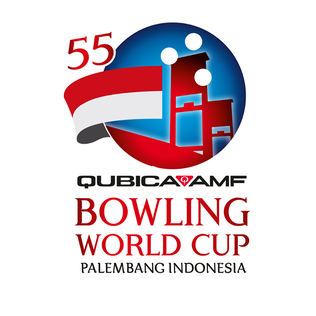
Nordic combined is a winter sport in which athletes compete in cross-country skiing and ski jumping. The Nordic combined at the Winter Olympics has been held since the first ever Winter Olympics in 1924, while the FIS Nordic Combined World Cup has been held since 1983. Many Nordic combined competitions use the Gundersen method, where placement in the ski jumping segment results in time (dis)advantages added to the contestant's total in the cross-country skiing segment.

The decathlon is a combined event in athletics consisting of ten track and field events. The word "decathlon" was formed, in analogy to the word "pentathlon", from Greek δέκα and ἄθλος. Events are held over two consecutive days and the winners are determined by the combined performance in all. Performance is judged on a points system in each event, not by the position achieved. The decathlon is contested mainly by male athletes, while female athletes typically compete in the heptathlon.

The FIS Alpine Ski World Cup is the top international circuit of alpine skiing competitions, launched in 1966 by a group of ski racing friends and experts which included French journalist Serge Lang and the alpine ski team directors from France and the USA. It was soon backed by International Ski Federation president Marc Hodler during the FIS Alpine World Ski Championships 1966 at Portillo, Chile, and became an official FIS event in the spring of 1967 after the FIS Congress at Beirut, Lebanon.

The FIS Nordic World Ski Championships is a biennial Nordic skiing event organized by the International Ski Federation (FIS). The World Championships was started in 1925 for men and opened for women's participation in 1954. World Championship events include Nordic skiing's three disciplines: cross-country skiing, ski jumping, and Nordic combined. From 1924 to 1939, the World Championships were held every year, including the Winter Olympics. After World War II, the World Championships were held every four years from 1950 to 1982. Since 1985, the World Championships have been held in odd-numbered years.
The World Cup of Golf is a men's golf tournament contested by teams of two representing their country. Only one team is allowed from each country. The players are selected on the basis of the Official World Golf Ranking, although not all of the first choice players choose to compete. The equivalent event for women was the Women's World Cup of Golf, played from 2005 to 2008.
The Canadian Open, also known as the Canada Masters, and currently branded as the National Bank Open presented by Rogers for sponsorship reasons, is an annual tennis tournament held in Ontario and Quebec. The men's competition is a Masters 1000 event on the ATP Tour, and the women's competition is a WTA 1000 tournament on the WTA Tour. The competition is played on outdoor hard courts.

The Japan women's national football team, or nicknamed Nadeshiko Japan (なでしこジャパン), represents Japan in women's association football and is run by the Japan Football Association (JFA). The only country to win every FIFA competition and the most successful women's national team in the Asian Football Confederation. Its highest ranking in the FIFA Women's World Rankings is 3rd, achieved in December 2011.
The 39th World Cup season began in October 2004 in Sölden, Austria, and concluded in March 2005 at the World Cup finals in Lenzerheide, Switzerland. The overall winners were Bode Miller of the U.S. and Anja Pärson of Sweden.
The 23rd World Cup season began in November 1988 in Austria and concluded in March 1989 in Japan. The overall champions were Marc Girardelli of Luxembourg and Vreni Schneider of Switzerland. Schneider established the record for victories in a World Cup season, winning a total of 14 races, surpassing the record of 13 established in 1978-79 by the great Swedish skier and three-time overall World Cup champion Ingemar Stenmark.
The 20th World Cup season began in August 1985 in Argentina, resumed in December 1985 in Italy, and concluded in March 1986 in Canada. Because of the South America events, this was the first time that the World Cup season had started prior to December 1. The overall champions were Marc Girardelli of Luxembourg, his second consecutive overall win, and Maria Walliser of Switzerland, her first.
The 18th World Cup season began in December 1983 in Kranjska Gora, Yugoslavia, and concluded in March 1984 in Oslo, Norway. The overall champions were Pirmin Zurbriggen and Erika Hess, both of Switzerland.
The 16th World Cup season began in December 1981 in France and concluded in March 1982, also in France. Phil Mahre of the US repeated as overall champion, the second of his three consecutive titles. Erika Hess of Switzerland won the women's overall title.
The 15th World Cup season began in December 1980 in France and concluded in March 1981 in Switzerland. Phil Mahre became the first American to win an overall title, the first of his three consecutive overall titles. Marie-Theres Nadig of Switzerland won the women's overall title.

The QubicaAMF Bowling World Cup, previously known as the International Masters and AMF Bowling World Cup, is an annual Ten-pin bowling championship sponsored by QubicaAMF Worldwide, and the largest in bowling in terms of number of participating nations. Each nation chooses one male and/or one female bowler to represent them in the tournament, and in the majority of cases, this is done by running a qualifying tournament, the winners of which are chosen.
Verawaty Fadjrin was an Indonesian badminton player who won international titles spanning from the late 1970s to the end of the 1980s. Tall and powerful, at one time or another she played each of the three variations of the sport at the highest world level.

The 1982 Women's Cricket World Cup, known as the 1982 Hansells Vita Fresh World Cup for sponsorship purposes, was an international cricket tournament played in New Zealand from 10 January to 7 February 1982. Hosted by New Zealand for the first time, it was the third edition of the Women's Cricket World Cup, coming four years after the previous 1978 World Cup in India.
The 1981 IAAF World Race Walking Cup was held on 3 and 4 October 1981 in the streets of Valencia, Spain. The event was also known as IAAF Race Walking World Cup.
For the 1924 Winter Olympics in Chamonix, France, a total of three sports venues were used. The main stadium was used for all but two sports and part of a third. It was the first ski jump used for the Winter Olympics. A bobsleigh track was prepared for use.
The European Combined Events Team Championships is a track and field competition for European combined track and field events specialists, with contests in men's decathlon event and women's heptathlon. It is organised by European Athletics. It was held annually in 1993–2011 and biennially in 1973–1993 and 2011–2019.
The European Bobsleigh and Skeleton Championships are the main bobsleigh and skeleton championships in Europe. The first bobsleigh European Championships with two-man event was held in 1929 in Davos, Switzerland. However, as Bobsleigh World Championships started to be held on an annual basis since following year, European Championships didn't resumed until 1965. A four-man event was included in 1967 when first combined championship occurred. The men's European Skeleton Championships were held separately in 1981–1988 before resuming in 2003 when women's skeleton event was added as well. In 2004 the first women's European Bobsleigh Championship was held with two-woman event. The following year both the women's bobsleigh and skeleton events were merged with the men's bobsleigh events at the European Championships. Since then, all bobsleigh and skeleton events are usually competes at the same time and venue. Women's monobob event was included in 2022.






